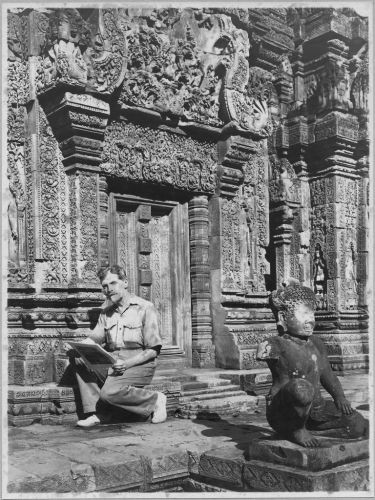
MARCHAL Henri (EN)
Biographical Article
After passing the baccalaureate in literature and philosophy as well as in literature and mathematics in 1895, Henri Marchal was admitted to the École des beaux-arts for architecture in the studio directed by Gaston Redon (1853-1921). At the same time, he gave lectures at popular universities and an evening course in industrial design at the Association polytechnique. Appointed inspector of civilian buildings in Cambodia in 1905, he carried out a mission to Thailand to prepare the project for a new French legation. In 1910, he passed the test for the Cambodian language certificate, and was appointed assistant curator of the School Museum in Phnom Penh (ភ្នំពេញ), as head of the new section of Khmer antiquities. In 1912, he was posted to Saigon as an inspector of civil buildings in Cochinchina. In 1916, following the death of Jean Commaille (1868-1916), he was dispatched to the École française d’Extrême-Orient (EFEO) to manage the conservation of Angkor. He first attended to the task of clearing the brush away from Angkor Wat (ប្រាសាទអង្គរវត្) and the major monuments constructed around the place Royale (Bayon [ប្រាសាទបាយ័ន], Baphuon [ប្រាសាទបាពួន], Palais royal, Preah Pithu ប្រាសាទព្រះ ពិ ធូរ, etc.). This enhancement of the central zone of Angkor Thom (អង្គរធំ) was complemented by the identification of numerous remains located inside or in the immediate vicinity of its perimeters. In 1919, Henri Marchal was appointed permanent member of the EFEO and curator of Angkor. He continued to clear the moats of Angkor Wat, while simultaneously seeing to occasional reinforcements at Bakheng (ប្រាសាទភ្នំបាខែង) [1922-1929], Baphuon, Bayon, the Victory Gate, and slightly peripheral monuments such as the Preah Khan (ប្រាសាទព្រះខ័ន) and the Banteay Kdei (ប្រាសាទបន្ទាយក្). However, he became aware of the limits of the reinforcements methods used at that point and, in 1930, went to Java to study the principles of anastylosis with the archaeological service of the Dutch Indies. On his return, he decided to implement them on the temple of Banteay Srei (ប្រាសាទបន្ទាយស្រី), which had been recently discovered (1931-1933). This restoration was unanimously praised. In 1933, Henri Marchal officially retired and left the conservation of Angkor to replace Henri Parmentier (1871-1949) as head of the EFEO's archaeological department. In 1938, on his way back to France, he made a stopover in Ceylon and India, of which he gave a vivid account in the Souvenirs d'un ancien conservateur d’Angkor. At the start of the war, he arrived in France, where he remained until 1946, when he carried out a mission to Pondicherry to take over the management of the Virampatnam shipyard. A year later, he was called back to replace Maurice Glaize (1886-1964) as curator of Angkor and remained there for six years. He restored the buildings located along the western causeway of Angkor Wat (1948) and also worked on the Terrace of the Elephants (ព្រះលានជល់ដំរី) (1948), Baphuon (1948), Banteay Kdei (1950), Prah Khan (1950), and Thommanon (ប្រាសាទធម្មនន្) (1950). After a brief stay in France, he returned to Hanoi to temporarily ensure the conservation of the Musée Louis Finot (1864-1935). In 1954, he was appointed technical advisor for historical monuments and head of the architecture office at the Ministry of Public Works of the Kingdom of Laos, a position he held until 1957. He then permanently retired and decided to remain in Cambodia. He moved to Siem Reap (សៀមរាប), where he died at the age of ninety-four.
Henri Marchal's life was intertwined for nearly forty years with the restoration work carried out on the Angkor site. He was deeply attached to Cambodia and the conservation of its heritage, so he professionalized the school’s undertakings and applied the processes developed in Greece and Java to Khmer monuments. Called upon to work on a large number of monuments, he gave precise descriptions, both in journals and excavation reports and in numerous monographs, which are an essential support for the architectural approach to many monuments.

The Collection
The collection consists of 3,096 stereoscopic images taken between 1905 and 1957 in Cambodia, Vietnam, Laos, China, Burma, Ceylon, and Thailand.
Related articles
Collection / collection d'une personne

Personne / personne











